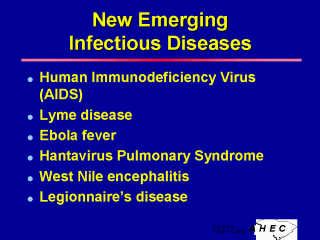| front |1 |2 |3 |4 |5 |6 |7 |8 |9 |10 |11 |12 |13 |14 |15 |16 |17 |18 |19 |20 |21 |22 |23 |24 |25 |26 |27 |28 |29 |30 |31 |32 |33 |34 |35 |review |
 |
Examples of emerging infectious diseases include: HIV/AIDS: First recognized in 1981, AIDS is caused by the HIV virus found in blood, semen, and vaginal secretions of infected persons. A strain of the virus has been circulating since at least 1959, and many believe that it evolved from a virus carried by a nonhuman primate. Lyme disease: First recognized in the 1970’s, it has emerged as the most frequently reported tick borne disease in the US with an average of over 12,000 cases reported annually since 1993. It is the most common vector-borne disease in the US, with the number of cases steadily increasing since 1990. Ebola virus: One of the deadliest viruses known, it causes a hemorrhagic fever. Ebola emerges periodically from unkown (probably small animal) natural reservoirs, accidentally infects humans and causes dramatic self-terminating outbreaks. Hantavirus pulmonary syndrome: Carried by rodents, it is a lung disease that was first identified during a 1993 outbreak in the southwestern US. It develops rapidly, causing severe pulmonary hemorrhage and death. West Nile encephalitis: First identified in the US in New York in 1999, it is a brain infection caused by viral and bacterial pathogens transmitted by mosquitoes. Mortality rates range from 3% to 15%, with slightly higher rates among the elderly. Legionnaire’s disease: First identified in Philadelphia in 1976, it is caused by the bacterium Legionella pneumophila. Transmitted through inhalation of aerosols of contaminated water, it is thought to account for 7% of all non-nosocomial pneumonias. (USDHHS 1998) |
| front |1 |2 |3 |4 |5 |6 |7 |8 |9 |10 |11 |12 |13 |14 |15 |16 |17 |18 |19 |20 |21 |22 |23 |24 |25 |26 |27 |28 |29 |30 |31 |32 |33 |34 |35 |review |